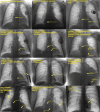EHRA consensus on prevention and management of interference due to medical procedures in patients with cardiac implantable electronic devices
- PMID: 36228183
- PMCID: PMC11636572
- DOI: 10.1093/europace/euac040
EHRA consensus on prevention and management of interference due to medical procedures in patients with cardiac implantable electronic devices
Keywords: CIED; Defibrillator; Electrocautery; Electrosurgery; ICD; Magnet mode; Magnetic resonance imaging; Pacemaker; Therapeutic radiation.
Conflict of interest statement
Conflict of interest: J.M.A.: speaker honoraria (Pfizer); M.B.: speaker honoraria (Medtronic); H.B.: speaker honoraria and institutional fellowship support (Abbott, Biotronik, Boston Scientific, Medtronic, Microport); G.D.S.: speaker honoraria (Novartis, Vifor Pharma, Daiichi Sankyo) E.F.: speaker honoraria (Daiichi Sankyo, Biosense Webster); R.G.: research grant (Boston Scientific; Medtronic, Microport, Abbott), speaker honoraria (Abbott), consultant (Microport); D.H.L.: speaker honoraria (Bayer, Boehringer-Ingelheim, Pfizer, Abbott, Medtronic, Biotronik, Microport CRM); R.L.: consultancy and speaker honoraria (Abbott, Biotronik, Boston Scientific, Boehringer-Ingelheim, Medtronic), institutional research grants (EU Horizon 2020 research and innovation programme; grant agreement nr. 847999); S.K.M.: speaker honoraria (Biosense Webster); J.C.N.: institutional research grants (Novo Nordisk Foundation); E.E.Ö.: speaker honoraria and consultant (Medtronic, Pfizer, Bayer, Sandoz); M.S.: speaker honoraria (Biotronik, Boehringer-Ingelheim, Bristol Myers Squibb, Daiichi Sankyo, Medtronic); Ar.S.: consultant (Abbott, Medtronic), speaker honoraria (Bayer, Abbott, Medtronic, Biosense Webster), institutional research grants (Abbott); J.T.R.: speaker honoraria (Medtronic, Abbott, Boston Scientific), research grant (Medtronic), and institutional fellowship support (Abbott); K.V.: consultant for Medtronic, Boston, Abbott, Philips, Biosense Webster; research/educational grants from Medtronic, Biosense webster, Philips, Abbott; I.C., G.E., Av.S., M.S., and W.T.Y.: none declared.
Figures










References
-
- von Olshausen G, Rondak IC, Lennerz C, Semmler V, Grebmer C, Reents T, et al. Electromagnetic interference in implantable cardioverter defibrillators: present but rare. Clin Res Cardiol 2016;105:657–65. - PubMed
-
- Hours M, Khati I, Hamelin J. Interference between active implanted medical devices and electromagnetic field emitting devices is rare but real: results of an incidence study in a population of physicians in France. Pacing Clin Electrophysiol 2014;37:290–6. - PubMed
-
- Nazarian S, Beinart R, Halperin HR. Magnetic resonance imaging and implantable devices. Circ Arrhythm Electrophysiol 2013;6:419–28. - PubMed
MeSH terms
LinkOut - more resources
Full Text Sources

